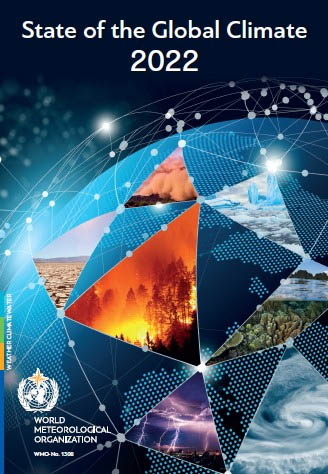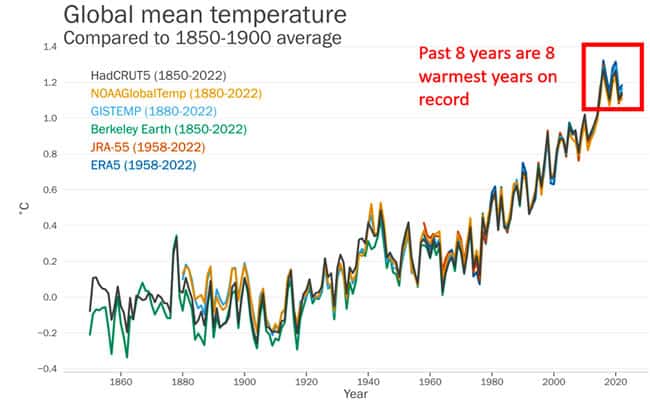
Climate Refugees in East Africa

The WMO report follows the release of the State of the Climate in Europe report by the EU’s Copernicus Climate Change Service. It complements the Intergovernmental Panel on Climate Change (IPCC) Sixth Assessment report, which includes data up to 2020.
Some of the report’s key findings:
Global mean temperature in 2022 was 1.15 [1.02 to 1.28] °C above the 1850-1900 average. The years 2015 to 2022 were the eight warmest in the instrumental record back to 1850. 2022 was the 5th or 6th warmest year. This was despite three consecutive years of a cooling La Niña – such a “triple-dip” La Niña has happened only three times in the past 50 years.
Concentrations of the three main greenhouse gases – carbon dioxide, methane, and nitrous oxide – reached record observed highs in 2021, the latest year for which consolidated global values are available (1984-2021). The annual increase in methane concentration from 2020 to 2021 was the highest on record. Real-time data from specific locations show levels of the three greenhouse gases continued to increase in 2022.
Reference glaciers for which we have long-term observations experienced an average thickness change of over −1.3 metres between October 2021 and October 2022. This loss is much larger than the average of the last decade. Six of the ten most negative mass balance years on record (1950-2022) occurred since 2015. The cumulative thickness loss since 1970 amounts to almost 30 m.
Sea ice in Antarctica dropped to 1.92 million km2 on February 25, 2022, the lowest level on record and almost 1 million km2 below the long-term (1991-2020) mean. For the rest of the year, it was continuously below average, with record lows in June and July. Arctic sea ice in September at the end of the summer melt tied for the 11th lowest monthly minimum ice extent in the satellite record.
Ocean heat content reached a new observed record high in 2022. Despite continuing La Niña conditions, 58% of the ocean surface experienced at least one marine heatwave during 2022.
Global mean sea level continued to rise in 2022, reaching a new record high for the satellite altimeter record. The rate of global mean sea level rise has doubled between the first decade of the satellite record (1993-2002, 2.27 mm∙yr-) and the last (2013-2022, 4.62 mm∙yr).
Ocean acidification: CO2 reacts with seawater resulting in a decrease of pH referred to as ‘ocean acidification’. Ocean acidification threatens organisms and ecosystem services. The IPCC Sixth Assessment Report concluded that “There is very high confidence that open ocean surface pH is now the lowest it has been for at least 26 [thousand years] and current rates of pH change are unprecedented since at least that time.
Drought gripped East Africa. Rainfall has been below-average in five consecutive wet seasons, the longest such sequence in 40 years. As of January 2023, it was estimated that over 20 million people faced acute food insecurity across the region, under the effects of the drought and other shocks.
Record breaking rain in July and August led to extensive flooding in Pakistan. There were over 1 700 deaths, and 33 million people were affected, while almost 8 million people were displaced. Total damage and economic losses were assessed at US$ 30 billion. July (181% above normal) and August (243% above normal) were each the wettest on record nationally.
Record breaking heatwaves affected Europe during the summer. In some areas, extreme heat was coupled with exceptionally dry conditions. Excess deaths associated with the heat in Europe exceeded 15 000 in total across Spain, Germany, the UK, France, and Portugal.
China had its most extensive and long-lasting heatwave since national records began, extending from mid-June to the end of August and resulting in the hottest summer on record by a margin of more than 0.5 °C. It was also the second-driest summer on record.

All climate models show record global temperatures today
Food insecurity: As of 2021, 2.3 billion people faced food insecurity, of which 924 million people faced severe food insecurity. Projections estimated 767.9 million people facing undernourishment in 2021, 9.8% of the global population. Half of these are in Asia and one third in Africa.
Heatwaves in the 2022 pre-monsoon season in India and Pakistan caused a decline in crop yields. This, combined with the banning of wheat exports and restrictions on rice exports in India after the start of the conflict in Ukraine, threatened the availability, access, and stability of staple foods within international food markets and posed high risks to countries already affected by shortages of staple foods.
Displacement: In Somalia, almost 1.2 million people became internally displaced by the catastrophic impacts of drought on pastoral and farming livelihoods and hunger during the year, of whom more than 60 000 people crossed into Ethiopia and Kenya during the same period. Concurrently, Somalia was hosting almost 35 000 refugees and asylum seekers in drought-affected areas. A further 512,000 internal displacements associated with drought were recorded in Ethiopia.
The flooding in Pakistan affected some 33 million people, including about 800 000 Afghan refugees hosted in affected districts. By October, around 8 million people have been internally displaced by the floods with some 585,000 sheltering in relief sites.


